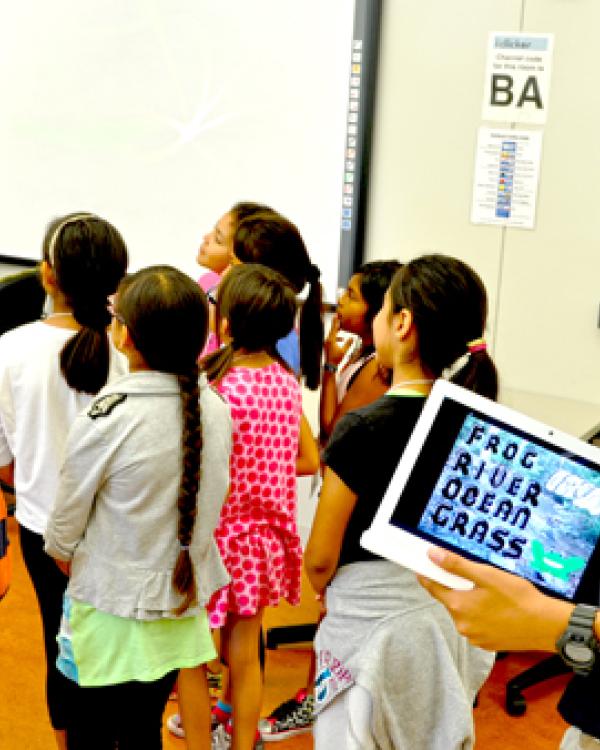
Prof. Gerardo Aldana runs a demo of a student project in his Harding Summer Enrichment Program technology class
A small class of Harding University Partnership School students, working in pairs, hunker over laptops, programming. They’re using a language called Scratch, developed so that children like them—in this case 4th graders—can do something they’d never thought they’d be able to accomplish. By programming, using actual if simple code, they end up animating a cartoon creature and make it move across their screens.
After a demo at the front of class illustrating what the students need to do, Professor of Chican@ Studies Gerardo Aldana tells the group, “First try. Then if you can’t do it, we’ll come and help.” He suggests in a later interview that “minimum instruction is best, but then we let them take off using their intuition and hunches. Plus by combining formal teachers and volunteers, they can get lots of personal help.” He and the group working with him work their way around the room, and you can practically see light bulbs going on over the children’s heads as the Scratch makes sense.
This session is just one part of the Harding University Partnership School (HUPS) Summer Enrichment Program going on now until July 3 at UC Santa Barbara’s Gevirtz School. During these three weeks 36 fourth, fifth, and sixth graders are exploring mathematics, science, and technology in classes taught by university professors, HUPS teachers, and graduate students. Created as a way to support HUPS’ GATE and high achieving students, the program provides students with access to a higher-level curriculum that challenges their critical thinking and analysis skills as well as helping them refine their current understandings. Gerardo Aldana stresses, “It’s way beyond what they’re doing during school.”
The students participate in workshop style classes with an emphasis on the Common Core State Standards and Next Generation Science Standards. On just day five of the program the science students were already proudly at the front of the class with posters presenting findings from experiments they had conducted earlier in the week, while the mathematics students were drawing diagrams as one means to discover answers to meter mysteries and pricing dilemmas. It was clear they were on their way to what HUPS Principal Vanesha Davis suggested in the program’s proposal, “It is my sincere hope that with this opportunity, students develop an avid interest in these subjects and pursue opportunities within these fields in the future.”
At this point just a pilot program, Davis says, “it is our hope this is the start of something great for our well deserving students.” Given how engaged students seemed a mere week in, it’s hard to imagine they won’t be even more involved—and educated—when they get the chance to work on a robotics project using Lego Mindstorm kits during the program’s last week.